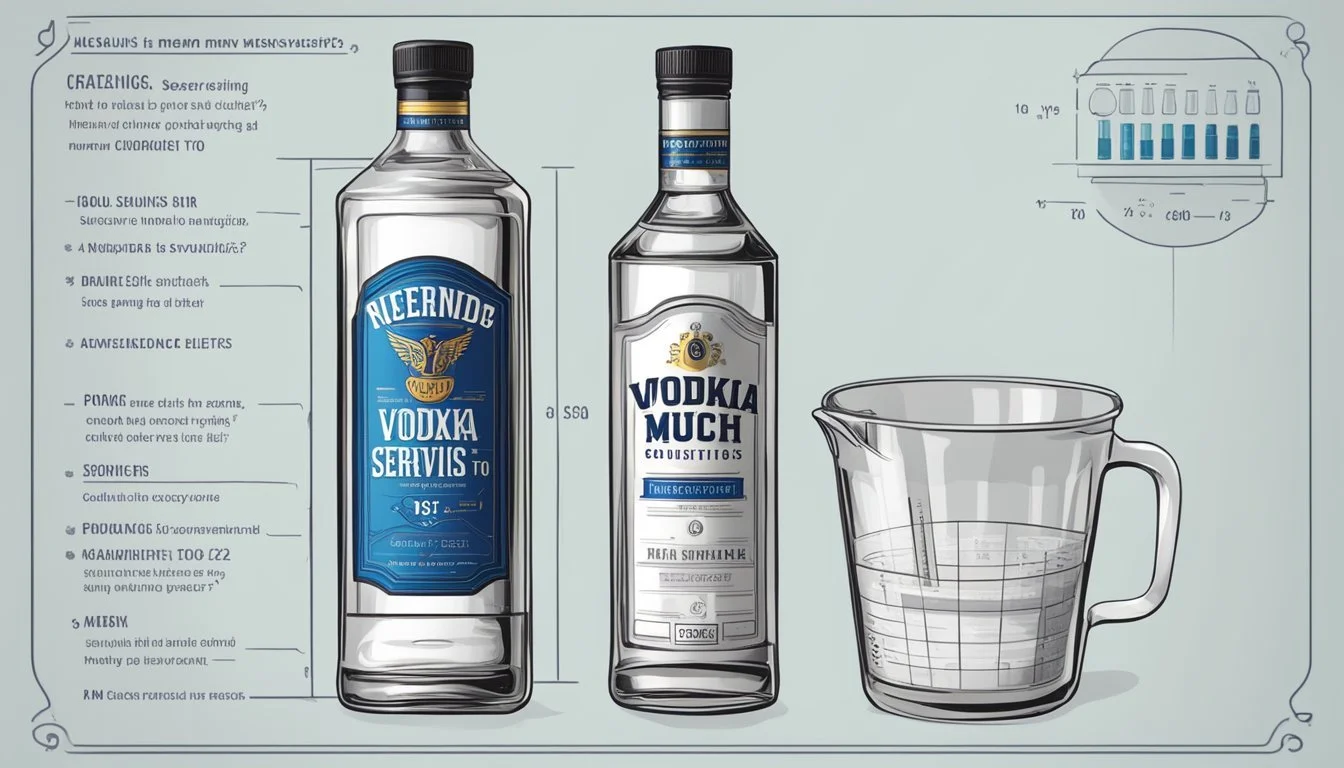How Many Servings of Vodka Is Too Much
Understanding Safe Consumption Limits
Vodka, like all alcoholic beverages, requires mindful consumption. Understanding what constitutes "too much" is crucial for maintaining health and well-being. Heavy drinking for men is defined as consuming 15 or more drinks per week, and for women, it is 8 or more drinks per week. This translates to more than 10.5 ounces of vodka a week for men and more than 5.25 ounces for women.
When it comes to daily consumption, experts recommend that men limit themselves to two standard drinks a day, while women should have no more than one. Binge drinking, which significantly raises blood alcohol concentration, occurs when a person consumes four or more drinks in a short period.
Maintaining these limits helps reduce the risk of alcohol-related health issues such as liver disease, heart problems, and certain cancers. Following these guidelines ensures that vodka remains a source of enjoyment rather than a danger to one's health.
Understanding Alcohol and Its Impact on Health
Alcohol consumption affects the body in various ways, depending on the type and amount of alcohol consumed. This includes variations in different beverages and both short-term and long-term health risks.
Alcohol Content in Different Beverages
Different alcoholic beverages contain varying amounts of alcohol, usually measured by Alcohol by Volume (ABV). For instance, 80 proof vodka is equal to 40% alcohol, while 110 proof vodka is equal to 55% alcohol. This means that a standard serving size of 1.5 fluid ounces of vodka contains a significant amount of alcohol.
Other beverages also have different ABV percentages:
Beer: Typically 12 fluid ounces with about 5% alcohol.
Wine: Typically 5 fluid ounces with about 12% alcohol.
Knowing these differences is crucial for understanding how much alcohol one is consuming and its potential health impacts.
Short and Long-Term Health Risks
Consuming alcohol, especially in large quantities, poses numerous health risks. Short-term effects can include impaired judgment, memory blackouts, and alcohol poisoning. These immediate health risks can lead to dangerous situations, such as accidents and acute alcohol-related problems.
Long-term alcohol consumption affects various organs and systems. Chronic use can lead to serious health conditions such as:
Liver disease: Including cirrhosis and liver inflammation.
Heart disease: Such as cardiovascular disease and increased risk of stroke.
Cancer: Including cancers of the esophagus, liver, and other areas.
Mental health issues: Such as depression and anxiety.
Additionally, prolonged alcohol use increases the risk of brain damage, exacerbates family history health issues, and can lead to chronic alcohol-related problems. Thus, moderation and awareness are key to reducing these health risks.
Defining Standard Drinking Measures
Knowing what constitutes a standard drink helps individuals gauge their alcohol intake and make informed choices.
Standard Drink Definitions and Equivalents
A standard drink in the United States contains approximately 14 grams of pure alcohol. This amount can vary significantly between different types of alcoholic beverages. For instance:
Regular Beer: 12 ounces (5% alcohol)
Wine: 5 ounces (12% alcohol)
Distilled Spirits (Gin, Vodka, Rum, etc.): 1.5 ounces (80 proof, or 40% alcohol)
Understanding these equivalents aids in recognizing how many standard drinks are in commonly consumed beverages.
Understanding Drink Equivalents in Common Containers
Standard drinks can come in a variety of containers, making it important to understand their drink equivalents:
A typical beer bottle or can (12 ounces) is one standard drink.
A typical bottle of craft beer may exceed the 5% alcohol content, impacting the total standard drinks.
Wine servings can vary, with restaurant glasses often holding more than five ounces.
Cocktails and mixed drinks can contain multiple shots of spirits, each counting as one standard drink per 1.5 ounces of 80-proof liquor.
These measures help delineate drinking limits and ensure responsible alcohol consumption.
Guidelines for Alcohol Consumption
Guidelines for alcohol consumption vary depending on gender, age, and individual health factors. It is essential to understand what constitutes moderate drinking and how the official dietary guidelines address alcohol use for different groups.
Moderate Drinking and Its Criteria
Moderate drinking is defined by the Centers for Disease Control and Prevention (CDC) as up to one drink per day for women and up to two drinks per day for men.
A standard drink is generally equivalent to:
12 fluid ounces of beer (about 5% alcohol)
5 fluid ounces of wine (about 12% alcohol)
1.5 fluid ounces of distilled spirits (about 40% alcohol)
It is crucial to adhere to these amounts to minimize health risks.
Dietary Guidelines for Different Genders and Ages
According to the 2020-2025 Dietary Guidelines for Americans, no one under the age of 21 should consume alcohol. Pregnant women and individuals managing conditions worsened by alcohol should avoid drinking altogether.
For women, the guideline is one drink per day. For men, the guideline is two drinks per day.
Always consider medications or medical conditions that may interact adversely with alcohol, and consult healthcare providers for personalized advice.
Considering Individual Factors
Individual factors such as genetics, metabolism, body size, gender, medications, and medical conditions play significant roles in determining how much vodka can be safely consumed. These aspects can influence an individual's alcohol tolerance, processing speed, and possible adverse reactions.
Impact of Genetics and Metabolism
Genetics affect how the body metabolizes alcohol. Enzymes like alcohol dehydrogenase and aldehyde dehydrogenase break down alcohol in the liver. Variations in these enzymes can result in different alcohol tolerance levels.
Family history of alcoholism can indicate a genetic predisposition to faster or slower alcohol metabolism. A slower metabolism can lead to higher blood alcohol concentration (BAC) and greater impairment.
Moreover, an individual's metabolic rate can vary significantly. Faster metabolisms process alcohol more efficiently, reducing its effects and leaving the bloodstream quicker.
Influence of Body Size and Gender
Body size directly influences alcohol distribution and BAC. Larger individuals generally have more body water, diluting alcohol more effectively and resulting in lower BAC levels. Conversely, smaller individuals experience higher BAC levels from the same amount of vodka.
Gender differences play a critical role. Women often have higher body fat percentages and lower body water content compared to men. This causes alcohol to remain concentrated in a smaller volume, leading to higher BAC.
Additionally, hormonal differences can affect alcohol metabolism rates. For instance, estrogen can slow down the process, causing women to feel the effects of alcohol more intensely.
Medication Interactions and Medical Conditions
Certain medications can interact with alcohol, leading to severe side effects. Antibiotics, antidepressants, and painkillers can intensify alcohol's depressive effects on the central nervous system. This may cause dizziness, drowsiness, and impaired coordination.
Medical conditions like liver disease or diabetes can also affect how the body processes alcohol. Liver diseases impair alcohol metabolism, leading to prolonged intoxication and increased damage to liver cells. Diabetes can cause dangerous fluctuations in blood sugar levels when alcohol is consumed.
People with these conditions or on medications should consult healthcare professionals to understand safe alcohol consumption levels. Ensuring they avoid negative interactions and manage their medical conditions effectively is vital.
The Role of Alcohol in Social and Behavioral Issues
Alcohol consumption has significant effects on social behavior and public safety. It impairs judgment and coordination, leading to increased risks and potentially severe consequences.
Alcohol's Effect on Behavior and Coordination
Alcohol impacts the central nervous system, impairing both behavior and physical coordination. Even moderate drinking can reduce inhibitions, leading to poor decision-making and increased risk-taking.
Coordination is particularly affected, making activities like driving and operating machinery hazardous. Falls and other accidents become more likely due to decreased motor skills.
Memory blackouts can occur, where individuals forget events that happened while they were intoxicated. This can result in dangerous situations, as people may not remember how they got home or who they interacted with.
Consequences of Alcohol Misuse in Public Safety
Excessive drinking is a major public safety concern. Drinking and driving is one of the leading causes of vehicle accidents and fatalities. Impaired judgment and slowed reaction times make driving under the influence extremely dangerous.
Alcohol-related assaults are also more common, as reduced inhibitions can lead to aggressive behavior. Drownings can occur when impaired judgment leads individuals to swim in unsafe conditions.
Public intoxication can result in legal consequences and damage to personal and professional relationships. The societal cost is significant, with resources diverted to manage the effects of alcohol misuse.
Seeking Help and Preventing Alcohol Abuse
Understanding strategies for moderation and reduction, as well as accessing resources for alcohol use disorders (AUD), can significantly aid those seeking to manage their alcohol consumption or help others in doing so.
Strategies for Moderation and Reduction
Implementing moderation strategies can play a critical role in preventing alcohol abuse. One approach is to set clear limits on drinking.
For instance, adults are advised to limit their intake to one drink per day for women and two for men, as outlined by the 2020-2025 U.S. Dietary Guidelines.
Avoiding binge drinking is crucial, defined as consuming four or more drinks in a few hours. Regular self-assessment and being aware of one's drinking habits can help recognize when limits are being exceeded.
Additionally, increasing the price of alcohol through taxes often leads to reduced consumption. Social support networks also provide accountability and encouragement.
Resources for Alcohol Use Disorders
Several resources are available for those experiencing Alcohol Use Disorders (AUD). Healthcare professionals are pivotal in helping assess the level of alcohol dependence, whether it be mild, moderate, or severe.
Alcoholics Anonymous (AA) and other support groups offer community support and shared experiences. For personalized assistance, psychotherapy and counseling, including cognitive-behavioral therapy (CBT), can target behavioral changes.
Medications prescribed by healthcare providers can also assist in reducing alcohol cravings and withdrawal symptoms. Online resources and hotlines provide immediate advice and support anytime it is needed. Establishing a comprehensive treatment plan with healthcare professionals ensures the most effective approach to managing and overcoming AUD.
Specific Considerations for Vodka Consumption
When determining the right amount of vodka to consume, several factors come into play. Vodka typically contains a high alcohol content, usually around 40%.
Standard Drinks: A standard drink in the US is defined as containing 14 grams of pure alcohol. For vodka, this translates to about 1.5 ounces or roughly one shot.
Empty Stomach: Consuming vodka on an empty stomach can lead to quicker and more intense intoxication. Food slows down the absorption of alcohol into the bloodstream.
Popular Brands: Brands like Absolut maintain a consistent alcohol content, making it easier to gauge the amount consumed.
Moderation: Moderation is key. Health organizations suggest that up to one standard drink per day for women and two for men is generally considered low-risk drinking.
Health Risks: Drinking vodka beyond these limits poses risks such as liver damage, addiction, and impaired driving.
Factors Influencing Effects: How fast and how much a person drinks are crucial. Drinking several shots in quick succession generally raises blood alcohol levels rapidly.
Individual Differences: Age, weight, and metabolic rate also influence how vodka affects an individual. Each person reacts differently based on these factors.
These considerations highlight the importance of understanding one's limits and consuming vodka responsibly.







